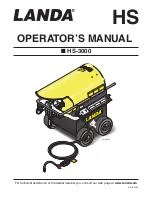
English
- 25 -
TABLE OF MAJOR SERVICING OPERATIONS TO BE
PERFORMED BY SERVICE CENTRE
Description of operations:
Boiler
Cleaning of coil
Descaling of coil
Cleaning of fuel pump
Replacement of fuel nozzle
Adjustment of electrodes
Replacement of electrodes
Replacement of lance nozzle
Calibrating and testing of
safety devices.
TABLE OF ROUTINE MAINTENANCE OPERATIONS
TO BE PERFORMED BY USER
Description of operations:
Inspection of power cable/hoses/high
pressure fittings
Replacement and cleaning of fuel filters
Cleaning of fuel tank
Cleaning of water filter
Every time appli-
ance is used
Every 100 hours
Every 100 hours
Every 50 hours
Every 200 hours
Every 300 hours
Every 200 hours
Every 200 hours
Every 200 hours
Every 500 hours
Every 200 hours
Once a year
IMPORTANT:
The times indicated are for normal operating conditions. For heavy use, reduce the time intervals for each operation.
When carrying out maintenance and/or repairs use only original spare parts, which guarantee better quality, reliabili-
ty and safety. Failure to use original spare parts will release the manufacturer from all liability, which passes
to the party carrying out the work.
LONG TERM STORAGE
If the appliance is to be out of service or mothballed for a lengthy period, it must be disconnected from the electricity and water
supplies; also, the tank/s that contain operating fluids must be emptied, and any parts liable to be damaged by accumulating
dust suitably protected.
Grease any parts that might be damaged by drying out, such as hoses. When preparing for storage, make sure the water hoses
are free of cracks or cuts.
Oils and chemical products must be disposed of in accordance with current statutory regulations.
SCRAPPING
If the decision is taken to decommission the appliance, it must be rendered inoperative by removing the electrical power cable.
In addition, parts of the appliance that could possibly present a hazard — especially to children who might use them as play-
things — should be rendered harmless.
The product is classified as WEEE type special waste and subject to the provisions of
new directives on environmental protection. It must be disposed of separately from ordinary waste in compliance with current
legislation and standards.
Components removed and destined for scrap must not be used as spare parts.
















































